|
|
 |
 |
 |
 |
| Parrot CK3300 bluetooth handsfree and GPS car kit review |
12th May 2005 |
|
 Review by Mike Barrett Review by Mike Barrett
In a lot of countries it is illegal to drive and use a mobile phone. Most legislation, however, allows you to use a handsfree carkit. Even where it is not yet against the law to use a mobile it makes sense to use a handsfree system purely for the sake of safety.
Parrot are a well known manufacturer of mobile phone accessories. In their product range they have a number of handsfree devices, but the one that caught our attention was the Parrot CK3300 handsfree car kit with an integrated bluetooth GPS receiver. |
|
| |
Overview
Founded in 1994 in Paris, by Henri Seydoux, Parrot SA is a well respected company providing solutions for mobile communications and mobile computing.
The Parrot CK3300 Advanced Car Kit is a bluetooth handsfree system which also incorporates a BT GPS receiver. This allows full connection to a Mobile phone and a GPS application from the same device.
The system is promoted as quote:
Parrot CK3000 Universal Car Kit is the reference for mobile professionals, selling in 35 countries. The first handsfree on the market with Bluetooth® wireless technology, the CK3000 is a truly universal solution.
With its quality built-in GPS receiver, CK3300 adds the navigation functions to the CK3100 handsfree features.
|
|
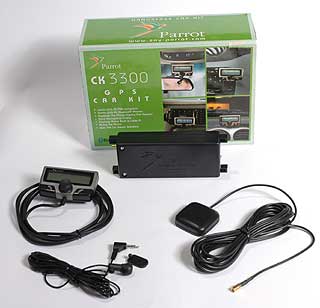 |
This all sound like utopia to me. In theory you can get into your car. Turn the ignition on and everything will connect up and start running. Well the reality did not quite match up to that, but it wasn't far off though.
|
What is in the box
The Parrot CK3300 (shown above right) comes with:
- The control box
- Radio mute cable
- LCD Screen
- Microphone
- Multi option LCD mounting kit
- GPS antenna
- ISO cabling set
As standard the kit uses the speakers from the car stereo for output. However this may not always be appropriate and Parrot provide an external speaker as an optional accessory pictured to the right. |
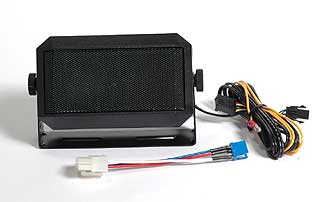 |
| |
Manufacturers Specifications
The main manufacturers specifications have been taken from the Parrot Website and edited to provide appropriate highlights:
Features
- Seamless hands-free use
- Superior user interface with LCD display
- Works with all bluetooth® Smartphones and PDA
- Can be installed in any vehicle
- Automatically mutes the radio
- Uses the car speakers
- Audio volume control
- Quality audio (Digital Signal Processing)
- Monitors and reduces the ambient noise
- Pairing up to five devices
- No cradle
- No wire, no headset
- No headset battery to charge
- Voice recognition dialer
- Software upgradeable
|
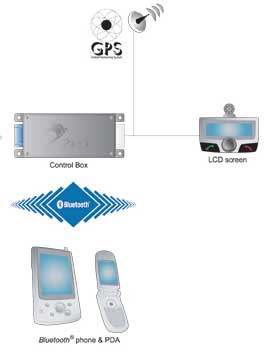 |
bluetooth® Features:
- Headset profile
- Handsfree profile 0.96
- Handsfree profile 1.0
- Phone book synchronisation
- Object push
GPS
- GPS 12 channels
- Active antenna
- NMEA over Bluetooth®
|
Telephony
- Caller ID
- Dialing with numbers
- Phonebook synchronisation including:
- last calls received
- last calls dialed
- Extension with new voicetags (up to 200)
- User connection priority management (up to 5 users)
- Wordspotting
|
| |
Compatibility Devices
There are a whole host of compatible phones, rather than list them all here I have provided this link to the official Parrot website.
When assessing if your combination will work be aware of the difference between the Headset profile and the Handsfree profile. The headset profile connects as and when it needs a connection, the handsfree is a permanent connection. At least that seemed to be the way it worked with my devices.
|
Compatibility navigation as Q1 2004:
- Tom Tom
- WayFinder
- Copilot
- Route66
- Audio Compass
- Navigon
- Destinator
As stated by Parrot |
You also need to be aware that despite the fact that a device may support a particular profile, you may need drivers to utilise it.
|
Installation
Installation is a doddle... assuming that you have a car with an ISO standard audio wiring loom.
When I was ordering the review sample I discovered that neither of my cars (Chrysler Voyager or Ford Probe) has a stereo with an ISO compatible wiring system. There are companies that make conversion leads between the proprietary audio systems and the ISO standard, but unfortunately not for either of these cars. The option I took was to order the auxiliary speaker. This then removed the need to intercept the car speakers etc.
In my eagerness to get it installed I removed the inside of my car dash board and had wires everywhere. I had purchased some cable clamps to allow me to tap into the power from the ignition, and off I went. Basically there are three power cables to connect up: permanent 12 volt, ignition switched 12 volt, and earth. There are then the connections for the LCD control screen, the GPS Antenna and the speakers, and Bobs your uncle it all works.
After testing to make sure all was OK I made everything nice and tidy, hid all the cables as much as possible, etc. Of course one of the things I did was remove the power to the stereo. When I turned it back on... Yes you have guessed it: Enter Keycode! And, Yes I didn't know what the keycode was. C'est la vie as they say in France. Even my son who had done this before could not remember the code. I found it eventually though.
After I got it all installed I thought I would test it a bit. Paired up my phone: no problem, Paired a PDA to the GPS: no problem. Took it out for a test drive: everything worked just fine.
Well it did for a while!
I didn't have the radio mute working as I didn't have the correct wiring loom, but it didn't matter as turning the radio down was not a big issue. What was a problem was that a few miles down the road the power failed to the control unit. This had me confused for a while until I realised that the connector I had bought to tap into the power lead had a poor and intermittent connection.
I searched around behind the dash for an alternative source of power, but not having the wiring manual I gave up and did what I should have done in the first place: Got an Auto-Electrician in to do the job.
|
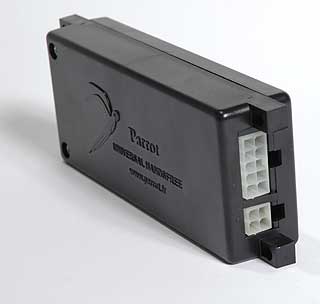

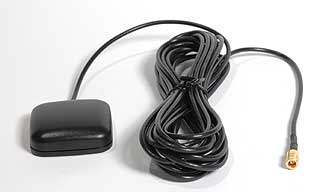
|
No more than 30 minutes after the guy had turned up he had the whole thing installed to a far better standard than I did. All the cables were hidden, and he had even rigged a relay up to mute the car radio. Happy days! Now I was in business and could really test the 3300 out properly.
|
The Parrot CK3300 in use
I tried the Parrot CK3300 with a number of mobile phones: an XDA, an Orange C500, and a Nokia 6310i. I also tried it with a number of PDAs, most of these worked extremely well. Unfortunately I never quite achieved my ideal setup.
What I really wanted to achieve was BT connection to phone for handsfree, BT connection to GPS for navigation, BT Audio from PDA for navigation instructions. I came very close with the C500, and an iPAQ 2210. I enabled the audio handset profile on the 2210 and managed to get the whole setup working, but only for a short while. After driving for a few minutes the BT seemed to crash on the PDA and neither voice instructions or GPS signals were received. Having said that that was an unfair test.
Setups that did work and worked well included:
An O2 XDA running TomTom 5.0. The XDA connects in headset mode and is quite different to the C500 which connects in handsfree mode. This setup was a dream as once it was all paired up and working correctly all I had to do was cradle the XDA and then start TomTom. The phone found the handsfree and GPS connections automatically. The XDA also used GPRS to connect to TomTom Traffic service.
My other setup that I used a lot was the C500 connecting to to the handsfree and the iPAQ 4700 connecting to the GPS and also the C500 for GPRS data. I have heard that the 4700 has a proper BT Audio gateway which should connect to the CK3300 for voice instructions. The only problem is that you need a driver to enable it and that is only available with the HP BT headphones.
In general I found that the signal received from the GPS was not as strong as some of the other GPS receivers I have used, typically it would report a 4-5 satellite fix when another receiver would have a 7-8 satellite fix. |
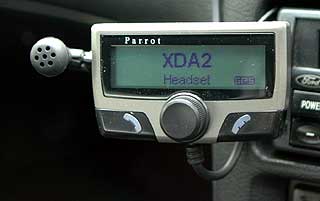
The Parrot CK3300 LCD control panel
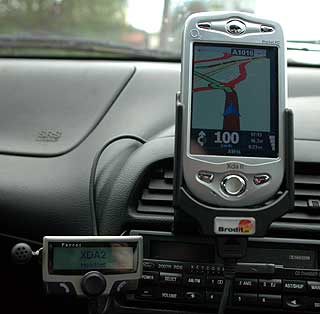
The Parrot CK3300 connected to the GPS for both mobile phone handsfree and BT GPS for TomTom.
(The wire above the LCD is nothing to do with this setup, it is the power cable for a TomTom carkit.) |
It also takes a while to get an initial fix when starting the journey.
One thing that was slightly irritating was the length of time it took to acquire all of the BT connections. This could be in excess of 45 seconds. The sort of time it takes to switch the car on, and reverse out of the drive. Some of this delay is down to the navigation software in use, and some is just general BT connection polling.
An interesting side issue was that when my wife started the car, it would connect to one of my phones in the office. On a couple of occasions the Parrot has grabbed a call that I was on at the time. This caused a great deal of confusion both to me and the person I was talking to at the time.
Whilst on the subject of the handsfree mobile function: the Parrot CK3300 was excellent compared to the other handsfree systems I have used. Admittedly these have normally been at the lower end of the range. I never once had any problems with the clarity of calls in the car. Most of the time there has not been any problems with background noise at the other end of the "line".
Different phones had different methods of connecting and transferring the phone books. With the Nokia 6310i the phonebook was automatically transferred when I paired the phone. With the XDA I could select the entire list of contacts and send them to the Parrot, and with the C500 I had to send individual contact details.
You can have up to 5 phones paired. Each phone will have it's own phonebook. This was a bit unfortunate for me as all my phones (hopefully) have the same contact databases in them. This meant that the CK3300 held 3 sets of identical information for each of the phones paired.
The Parrot CK3300 supports voice commands. I don't know how good these are as I tend not to use voice dialling or voice commands. I always seem to use a different voice when talking to a machine and never seem to get it right. What I do like though is the knob on the LCD panel which you can use to quickly dial any number stored in the Parrot. Whilst using the knob the Parrot "speaks" the selected action. I found this a bit irritating after a while so selected the configuration to avoid spoken menu options.
One little "gotcha" is that when you are pairing an XDA or WM Smartphone you must initiate the pairing on the Parrot and select Windows mobile. This will allow you to connect to both the Handsfree and the GPS ports. It took me quite a while playing around with my XDA to work that one out. With my C500 I was never able to find out how to get the BT GPS configured. The phone only reports on device and TomTom does not seem to find it. I eventually gave up trying, and just used the Parrot as a handsfree carkit for the C500.
I was not able to test the configuration, but I have been informed that devices like the Nokia 6600 which only support a single BT connection can actually connect to the Handsfree, BT GPS and Audio gateway all at the same time. From what I gather it is a bit of a kludge, but it works.
|
Issues and Problems
All the issues and problems I experienced during my testing of the Parrot CK3300 were not directly attributable to the CK3300. Having said that the CK3300 can be used in a wide range of configurations, you need to contact the dealer to confirm if your equipment will connect in the manner that you want it too. There seemed to be little detailed knowledge easily obtainable from random dealers that I contacted, or the Parrot website.
When I had the 2210 using the CK3300 as an audio gateway and getting the navigation instructions from it the first part of the instruction was clipped as the handsfree switched in. Modifying the voice instruction files would overcome this, but then some parts of the navigation instructions would probably not flow so well.
It has been reported that in some configurations when a phone call is received that the GPS signal will be lost until the call has completed. I have not experienced this myself, and have tested extensively with the XDA and had perfect GPS reception at the same time as making and receiving calls. |
|
Conclusions
There are an incredible number of combinations that the Parrot CK3300 can be configured for and it is impossible for us to check each one in this review. The limitations that I found seemed to be imposed by the connecting equipment rather than the Parrot CK3300. The advice is to check out your expected configuration before purchase.
Although the Parrot comes with industry standard ISO connectors we had the choice of 3 cars to fit it to and not one of these had either ISO connectors, or cable set adapters to convert the factory loom to ISO. I would encourage anyone considering fitting a handsfree carkit like this to have it installed by a professional, unless they have a car with ISO connectors.
Using it as a handsfree carkit with a mobile phone and as a GPS with a PDA seems to be one of the best options with the XDA type of device being an ideal solution, but I am also happy with my Orange C500 and iPAQ 4700. |
Pros
- Provides a legal way to use your mobile when on the road.
- Easy to use once setup
- Bluetooth devices just connect
- Lots of configuration options
|
Cons
- Needs professional installation
- Dependent on the connected devices
- Complicated for a novice to set up
- GPS not the most sensitive
- No useable audio gateway on most PDAs
|
|
|
|
 |
 |
 |
 |
|
|